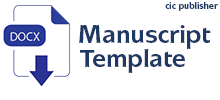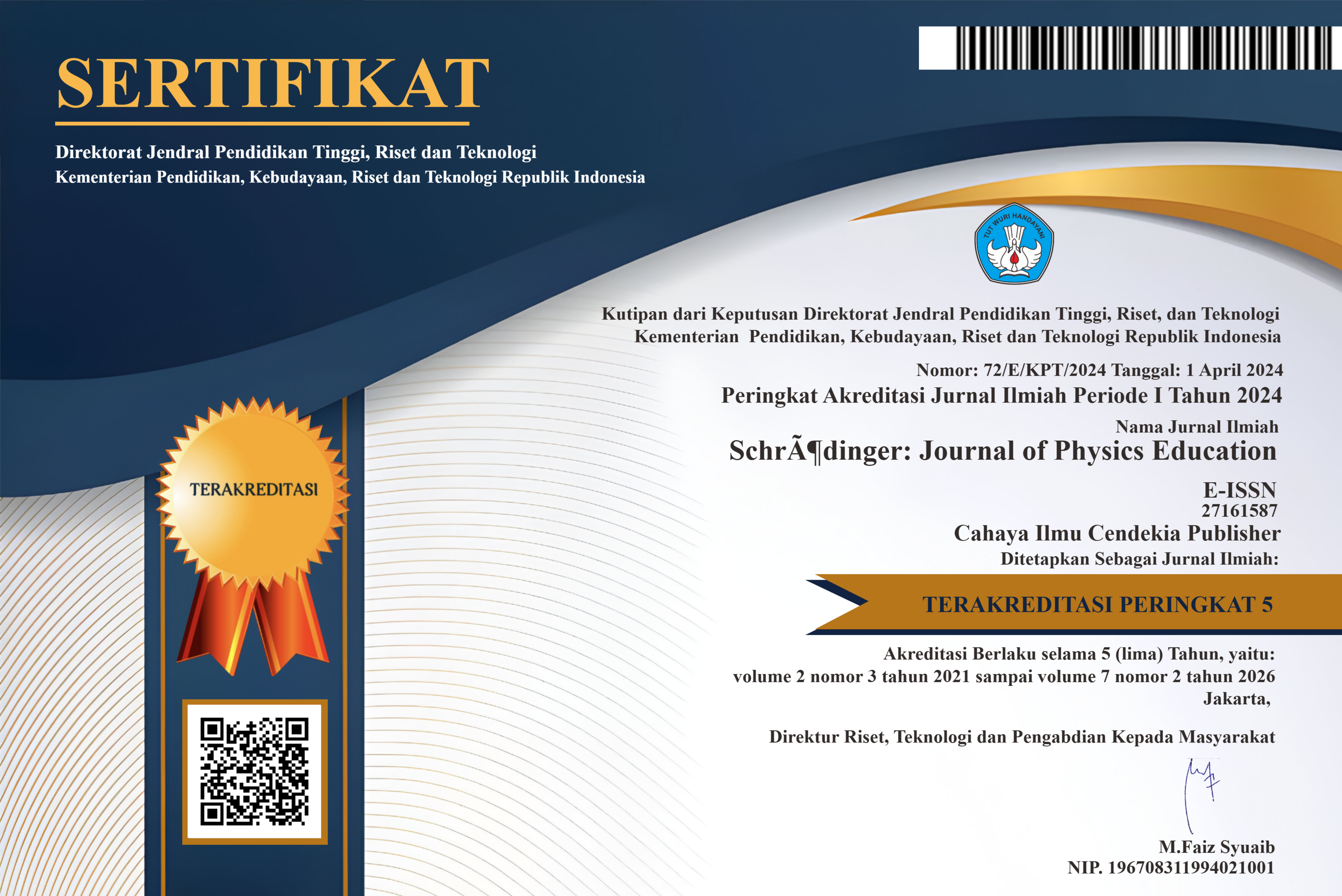Classify, Measure, Tabulate: Exploring Teacher Strategies in Shaping Scientific Process Skills in Phase Change Physics
Abstract
Purpose of the study: This study aims to explore and describe the strategies used by physics teachers to enhance students’ scientific process skills specifically in classifying, measuring, and tabulating data during the learning of phase changes of matter in senior high school.
Methodology: This study employed a qualitative naturalistic approach. Data were collected using in-depth interviews and photographic documentation. The participants included one physics teacher and 36 students of class XI F7 Senior High School 10 Jambi City. Istruments used were interview guidelines and documentation sheets. Data analysis followed the stages of data reduction, data display, and conclusion drawing.
Main Findings: The study found that teachers implemented various strategies to improve students’ scientific process skills, particularly in classifying, measuring, and constructing data tables during the learning of phase changes of matter. Through structured guidance, contextual examples, and supportive assessments, students showed improved accuracy and independence in scientific data handling. Both teacher and student responses indicated that strategy-based teaching effectively enhanced students’ analytical and practical competencies in physics learning.
Novelty/Originality of this study: This study offers a fresh perspective by exploring teacher strategies specifically designed to enhance students’ abilities in classifying, measuring, and tabulating data within the topic of phase changes in physics. Unlike previous research, it integrates pedagogical, methodological, and model-based approaches, contributing new insights into the development of scientific process skills in secondary education settings.
References
R. Sebastian, P. Winingsih, N. Amalia, and P. Hapsari, “Content analysis of the independent curriculum physics science textbook from the perspective of critical thinking aspects and HOTS,” Momentum Phys. Educ. J., vol. 7, no. 2, pp. 232–246, 2023, doi: 10.21067/mpej.v7i2.8293.
S. Maestrales, X. Zhai, I. Touitou, Q. Baker, B. Schneider, and J. Krajcik, “Using machine learning to score multi dimensional assessments of chemistry and physics,” J. Sci. Educ. Technol., vol. 30, pp. 239–254, 2021, doi: 10.1007/s10956-020-09895-9.
M. C. Fitzhugh and J. Pa, “Longitudinal changes in resting-state functional connectivity and gray matter volume are associated with conversion to hearing impairment in older adults,” J. Alzheimer’s Dis., vol. 86, no. 2, pp. 905–918, 2022, doi: 10.3233/JAD-215288.Longitudinal.
B. Yang, X. Zhu, M. Liu, and Z. Lv, “Review on the application of machine vision in defrosting and decondensation on the surface of heat exchanger,” J. Sustain., vol. 14, no. 11606, pp. 1–15, 2022, doi: 10.3390/su141811606.
T. Gu, Y. Zhao, Y. Liu, and D. Wang, “A review of condensation frosting mechanisms and promising solutions,” J. Sustain., vol. 13, no. 493, pp. 1–16, 2023, doi: 10.3390/cryst13030493.
G. S. Budi, F. Farcis, and T. J. Hartanto, “Persepsi mahasiswa terhadap pelaksanaan pembelajaran berbasis riset pada materi perpindahan kalor [Student perceptions of the implementation of research-based learning on heat transfer material],” J. Ilm. Kanderang Tingang, vol. 16, no. 1, pp. 33–42, 2025, doi: 10.37304/jikt.v16i1.340.
F. Maulida, F. Alatas, and D. Solehat, “Studi literatur miskonsepsi pembelajaran hukum 1 termodinamika: identifikasi dan solusi [Literature study of misconceptions in learning the 1st law of thermodynamics: identification and solutions],” Semin. Nasioanl FITK UIN Jakarta, vol. 1, no. 1, pp. 170–180, 2024.
Z. Koyunlu Ünlü and İ. Dökme, “A systematic review of 5E model in science education: proposing a skill-based STEM instructional model within the 21-st century skills,” Int. J. Sci. Educ., vol. 44, no. 13, pp. 2110–2130, 2022, doi: 10.1080/09500693.2022.2114031.
F. Novitra, Festiyed, Yohandri, and Asrizal, “Development of Online-based Inquiry Learning Model to Improve 21st-Century Skills of Physics Students in Senior High School,” Eurasia J. Math. Sci. Technol. Educ., vol. 17, no. 9, pp. 1–20, 2021, doi: 10.29333/ejmste/11152.
D. Ambarita, J. Dahliah, Y. Edwar, M. S. Hartati, and U. M. Bengkulu, “Perspektif filsafat progresivisme dalam kurikulum merdeka [The perspective of the philosophy of progressivism in the independent curriculum],” Indones. J. Innov. Multidisipliner Res., vol. 3, no. 1, pp. 366–380, 2025, doi: 3025-0994.
H. N. Saputra, A. Abdulkarim, and S. Fitriasari, “Analisis penerapan kurikulum merdeka dalam pembelajaran abad ke-21 di SMP Daarut Tauhiid Boarding School [Analysis of the implementation of the independent curriculum in 21st century learning at Daarut Tauhiid Boarding School Junior High School],” Sanskara Pendidik. dan Pengajaran, vol. 2, no. 02, pp. 86–96, 2024, doi: 10.58812/spp.v2i02.309.
A. Kurniawati, “Science process skills and its implementation in the process of science learning evaluation in schools,” J. Sci. Educ. Res., vol. 5, no. 2, pp. 16–20, 2021, doi: 10.21831/jser.v5i2.44269.
G. G. Gizaw and S. S. Sota, “Improving science process skills of students: a review of literature,” Sci. Educ. Int., vol. 34, no. 3, pp. 216–224, 2023, doi: 10.33828/sei.v34.i3.5.
E. F. S. Rini and F. T. Aldila, “Practicum activity: analysis of science process skills and students’ critical thinking skills,” Integr. Sci. Educ. J., vol. 4, no. 2, pp. 54–61, 2023, doi: 10.37251/isej.v4i2.322.
M. Uliyandari, Emilia Candrawati, Anna Ayu Herawati, and Nurlia Latipah, “Problem-based learning to improve concept understanding and critical thinking ability of science education undergraduate students,” IJORER Int. J. Recent Educ. Res., vol. 2, no. 1, pp. 65–72, 2021, doi: 10.46245/ijorer.v2i1.56.
R. Agustini, “Analysis of science process skills of chemical education students through self-project based learning (sjbl) in the covid-19 pandemic era,” J. Technol. Sci. Educ., vol. 11, no. 2, pp. 371–387, 2021, doi: 10.3926/jotse.1288.
H. Almazroa and W. Alotaibi, “Teaching 21st century skills: understanding the depth and width of the challenges to shape proactive teacher education programmes,” Sustain., vol. 15, no. 9, pp. 1–25, 2023, doi: 10.3390/su15097365.
M. Göhner and M. Krell, “Preservice science teachers’ strategies in scientific reasoning: the case of modeling,” Res. Sci. Educ., vol. 52, no. 2, pp. 395–414, 2022, doi: 10.1007/s11165-020-09945-7.
M. Baran, M. Baran, F. Karakoyun, and A. Maskan, “The influence of project-based STEM (PjBL-STEM) applications on the development of 21st-century skills,” J. Turkish Sci. Educ., vol. 18, no. 4, pp. 798–815, 2021, doi: 10.36681/tused.2021.104.
D. Cahyani Nugraheny, Z. Syukrilah, F. Haliza, and F. Zahroh, “Kurikulum merdeka di sekolah menengah pertama [Independent curriculum in junior high schools],” PUSAKA J. Educ. Rev., vol. 1, no. 1, pp. 1–11, 2023, doi: /10.56773/pjer.v1i1.9.
N. A. Shalehah, “Studi literatur: konsep kurikulum merdeka pada satuan pendidikan anak usia dini [Literature study: the concept of independent curriculum in early childhood education units],” J. Ilm. Cahaya Paud, vol. 5, no. 1, pp. 70–81, 2023, doi: 10.33387/cahayapd.v5i1.6043.
D. Herdiansyah, N. H. Puteri, Q. A. Hamza, and R. Naini, “Optimalisasi open-mindedness character strengths dalam upaya meningkatkan critical thinking siswa guna mencapai profil pelajar Pancasila [Optimizing open-mindedness character strengths in an effort to improve students’ critical thinking in order to achiev,” J. Bimbing. Konseling Flobamora, vol. 2, no. 3, pp. 119–134, 2024, doi: 10.35508/jbkf.v2i3.19600.
L. Wulandari, S. Sainuddin, and A. J. Suharli, “Penilaian keterampilan proses sains pada praktikum mahasiswa di laboratorium kimia [Assessment of science process skills in student practicums in the chemistry laboratory],” Exp. J. Sci. Educ., vol. 5, no. 1, pp. 45–53, 2025, doi: 10.18860/experiment.v5i1.32730.
L. Inayah and A. Malik, “Hakikat dan peran kegiatan laboratorium dalam pembealajaran : analisis model praktikum cookbook laboratorium pada inquiry lab [The nature and role of laboratory activities in learning: analysis of the laboratory cookbook practicum model in inquiry lab],” Indones. J. Sci. Learn., vol. 5, no. 1, 2024, doi: 10.15642/ijsl.v5i1.3798.
L. S. Maya, “Implementasi metode eksperimen untuk mengembangkan keterampilan proses sains dan literasi sains anak usia dini [Implementation of experimental methods to develop science process skills and science literacy in early childhood],” J. Teknol. Pendidik. dan Pembelajaran, vol. 8, no. 1, pp. 88–98, 2021, doi: 10.62870/jtppm.v8i1.11895.
R. Safrudin, Zulfamanna, M. Kustati, and N. Sepriyanti, “Penelitian kualitatif,” J. Soc. Sci. Res., vol. 3, no. 2, pp. 1–15, 2023, doi: 2807-4238.
F. Nyimbili and L. Nyimbili, “Types of purposive sampling techniques with their examples and application in qualitative research studies,” Br. J. Multidiscip. Adv. Stud., vol. 5, no. 1, pp. 90–99, 2024, doi: 10.37745/bjmas.2022.0419.
L. Herayanti, H. Habibi, and B. A. Sukroyanti, “Development of inquiry-based teaching materials to improve physics teacher’s conseptual understanding,” J. Penelit. Pendidik. IPA, vol. 8, no. 6, pp. 3110–3116, 2022, doi: 10.29303/jppipa.v8i6.2543.
M. K. Scheuerman, A. Hanna, and E. Denton, “Do datasets have politics? Disciplinary values in computer vision dataset development,” Proc. ACM Human-Computer Interact., vol. 5, no. CSCW2, pp. 1–37, 2021, doi: 10.1145/3476058.
H. H. Chai, S. S. Gao, K. J. Chen, D. Duangthip, E. C. M. Lo, and C. H. Chu, “A concise review on qualitative research in dentistry,” Int. J. Environ. Res. Public Health, vol. 18, no. 3, pp. 1–13, 2021, doi: 10.3390/ijerph18030942.
A. I. Ningi, “Data presentation in qualitative research: the outcomes of the pattern of ideas with the raw data,” Int. J. Qual. Res., vol. 1, no. 3, pp. 196–200, 2022, doi: 10.47540/ijqr.v1i3.448.
B. W. Furidha and U. M. Sidoarjo, “Comprehension of the descriptive qualitative research method: a critical assessment of the literature,” ACITYA WISESA J. Multidiscip. Res., vol. 2, no. 4, pp. 1–8, 2023, doi: 10.56943/jmr.v2i4.443.
L. Ma, “An immersive context teaching method for college english based on artificial intelligence and machine learning in virtual reality technology,” Mob. Inf. Syst., vol. 7, pp. 1–7, 2021, doi: 10.1155/2021/2637439.
M. Qorib, “Analysis of differentiated instruction as a learning solution in student diversity in inclusive and moderate education,” IJRS Int. J. Reglem. Soc., vol. 5, no. 1, pp. 43–55, 2024, doi: 10.55357/ijrs.v5i1.452.
L. Rahman, “Vygotsky’s zone of proximal development of teaching and learning in STEM education,” Int. J. Eng. Res. Technol., vol. 13, no. 8, pp. 1–7, 2024, [Online]. Available: https://www.ijert.org/
M. Latukau, “Pembelajaran IPA dengan model inkuiri terbimbing untuk meningkatkan pemahaman konsep dan keterampilan proses sains siswa SD [Science learning with a guided inquiry model to improve elementary school students’ understanding of science concepts and process ,” J. Ilm. Wahana Pendidik., vol. 8, no. 23, pp. 351–362, 2022, doi: 10.5281/zenodo.7397601.
T. Adhikari, “Enhancing quality of basic level education through demonstration method,” Triyuga Acad. J., vol. 3, no. 1, pp. 190–207, 2024, doi: 10.3126/taj.v3i1.71980.
J. L. Jackson and C. L. Stenger, “Methods of explicitly teaching generalization in the mathematics classroom and indicators of success: a systematic review,” Int. J. Educ. Math. Sci. Technol., vol. 12, no. 4, pp. 1109–1126, 2024, doi: 10.46328/ijemst.4171.
N. Ute, H. Hunaidah, E. Erniwati, L. O. Nursalam, and L. Sukariasih, “Pengaruh metode pembelajaran dengan pendekatan inkuiri terbimbing terhadap pemahaman konsep dan motivasi belajar fisika [The influence of learning methods with a guided inquiry approach on understanding concepts and motivation to learn physics],” J. Pendidik. Fis., vol. 9, no. 1, p. 1, 2021, doi: 10.24127/jpf.v9i1.3524.
S. Cai, C. Liu, T. Wang, E. Liu, and J. C. Liang, “Effects of learning physics using augmented reality on students’ self-efficacy and conceptions of learning,” Br. J. Educ. Technol., vol. 52, no. 1, pp. 235–251, 2021, doi: 10.1111/bjet.13020.
P. Srikan, P. Pimdee, P. Leekitchwatana, and A. Narabin, “A problem-based learning (pbl) and teaching model using a cloud-based constructivist learning environment to enhance thai undergraduate creative thinking and digital media skills,” Int. J. Interact. Mob. Technol., vol. 15, no. 22, pp. 68–83, 2021, doi: 10.3991/IJIM.V15I22.24963.
A. Musliman and U. Kasman, “Efektivitas model inkuiri terbimbing untuk melatih kemampuan berpikir kritis siswa pada konsep fisika yang bersifat abstrak [The effectiveness of guided inquiry models to train students’ critical thinking skills in abstract physics concepts],” J. Jendela Pendidik., vol. 2, no. 01, pp. 48–53, 2022, doi: 10.57008/jjp.v2i01.116.
D. Savitha, T. Anto, and S. Tv, “Introducing reflective narrative for first-year medical students to promote empathy as an integral part of physiology curriculum,” Adv. Physiol. Educ., vol. 45, no. 2, pp. 207–216, 2021, doi: 10.1152/ADVAN.00206.2020.
N. Thambu, H. J. Prayitno, and G. A. N. Zakaria, “Incorporating active learning into moral education to develop multiple intelligences: a qualitative approach,” Indones. J. Learn. Adv. Educ., vol. 3, no. 1, pp. 17–29, 2021, doi: 10.23917/ijolae.v3i1.10064.
Y. F. Surya and I. Aprinawati, “Review strategi komunikasi humanis dalam meningkatkan keterampilan proses sains pada pendidikan sekolah dasar [Review of humanistic communication strategies in improving science process skills in elementary school education],” J. Commun. Linguist., vol. 1, no. 1, pp. 32–44, 2025, [Online]. Available: https://cls.tpi.or.id/cls/article/view/5
S. Pokhrel, “Inovasi kurikulum berdasarkan komponen kurikulum evaluasi untuk menghadapi tantangan di era globalisasi [Curriculum innovation based on evaluation curriculum components to face challenges in the era of globalization],” J. Innov. Res. Knowl., vol. 15, no. 1, pp. 37–48, 2024, [Online]. Available: https://bajangjournal.com/index.php/JIRK/article/view/9085
M. Z. Iqbal and M. Q. Ali, “Improving practicum outcomes: common errors and reflective practices of future educators Muhammad,” J. Policy Options, vol. 7, no. 2, pp. 20–28, 2024, [Online]. Available: http://resdojournals.com/index.php/jpo/article/view/364
Copyright (c) 2025 Evi Ramna Farni, Sarah Pramitha

This work is licensed under a Creative Commons Attribution 4.0 International License.
Authors who publish with this journal agree to the following terms:
- Authors retain copyright and acknowledge that the Schrödinger: Journal of Physics Education is the first publisher licensed under a Creative Commons Attribution 4.0 International License.
- Authors are able to enter into separate, additional contractual arrangements for the non-exclusive distribution of the journal's published version of the work (e.g., post it to an institutional repository or publish it in a book), with an acknowledgment of its initial publication in this journal.
- Authors are permitted and encouraged to post their work online (e.g., in institutional repositories or on their website) prior to and during the submission process, as it can lead to productive exchanges and earlier and greater citation of published work.







.png)
.png)








.png)
.png)
.png)







